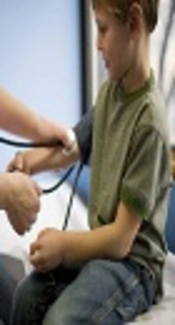1. Background
Obstruction lesion in the urinary tract could occur in any section of the meatus to infundibulum of the calyx. Most causes of this obstruction are congenital (1). Obstruction in the urinary tract may be identified by ultrasonography during pregnancy (2). Systolic and diastolic blood pressure usually increase from the one to eighteen years old. Hypertension in children is defined as blood pressure being greater than 95th percentile considering age, gender, and height (3). Kidney disease is the most common reason for secondary HTN in children (4, 5). Blood pressure of less than the 90th percentile is normal and blood pressure between 90th and 95th is pre-HTN (6).
Because HTN can cause major organ damage and early diagnosis can prevent this damage, in this study, the researchers compared blood pressure in healthy children and children with hydronephrosis.
2. Methods
This was a case control study that was done on children older than four years old. The case group included children with hydronephrosis that referred to the pediatrics clinic of Amirkabir hospital in Arak, Iran. At the same time, healthy children without any problem in their kidney and urinary system and with the same demographic condition (age, gender, socioeconomic status, etc.) entered the control group.
Blood pressure and height of children were measured. For measuring the blood pressure, standard methods and citizen digital blood pressure monitor were used (REFCH-311B).
3. Results
In this study, 108 children with hydronephrosis entered the case group and 220 healthy children entered the control group. The mean age of these children was 7.52 ± 2.48 years old (Table 1). In this study, 140 children (42.7%) were male and 188 (57.3%) were female (Table 2). The mean weight of these children was 26.46 ± 10.85 kg (Table 3). The mean height of these children was 124.27 ± 16.49 cm (Table 4).
| Group | Mean | Standard Deviation | P-Value |
|---|---|---|---|
| Case | 7.28 | 2.43 | 0.233 |
| Control | 7.63 | 2.51 | |
| Total | 7.52 | 2.48 |
Children’s Age
| Group | Gender, No. (%) | P-Value | |
|---|---|---|---|
| Male | Female | ||
| Case | 42 (38.9) | 66 (61.1) | 0.330 |
| Control | 98 (44.5) | 122 (55.5) | |
| Total | 140 (42.7) | 188 (57.3) | |
Children’s Gender
| Group | Mean | Standard Deviation | P-Value |
|---|---|---|---|
| Case | 25.47 | 10.65 | 0.244 |
| Control | 26.95 | 10.94 | |
| Total | 26.46 | 10.85 |
Children’s Weight
| Group | Mean | Standard Deviation | P-Value |
|---|---|---|---|
| Case | 122.51 | 10.65 | 0.178 |
| Control | 125.12 | 16.78 | |
| Total | 124.27 | 16.49 |
Children’s Height
This study showed that 10 children of the control group (4.5%) had diastolic HTN, blood pressure of 23 children in the control group (10.5%) was in the pre-HTN range, and blood pressure of five children in the case group (4.6%) was in the pre-HTN range (Table 5).
| Group | Diastolic BP, No (%) | P-Value | ||
|---|---|---|---|---|
| Normal | Pre HTN | HTN | ||
| Case | 103 (95.4) | 5 (4.6) | 0 (0) | 0.013 |
| Control | 187 (85.0) | 23 (10.5) | 10 (4.5) | |
| Total | 290 (88.4) | 28 (8.5) | 10 (3.0) | |
Diastolic Blood Pressure in Children
Also, this study showed that 12 children of the control group (5.5%) had diastolic HTN, blood pressure of 11 children in the control group (5.0%) was in the pre-HTN range, and one child in the case group (0.9%) had blood pressure in the pre-HTN range (Table 6).
| Group | Systolic BP, No (%) | P-Value | ||
|---|---|---|---|---|
| Normal | Pre HTN | HTN | ||
| Case | 107 (99.1) | 1 (0.9) | 0 (0) | 0.007 |
| Control | 197 (89.5) | 11 (5.0) | 12 (5.5) | |
| Total | 304 (92.7) | 12 (3.7) | 12 (3.7) | |
Systolic Blood Pressure in Children
4. Discussion
Although prevalence of chronic kidney disease in children is less than adults, in these children the prevalence of HTN is 10 times more than healthy children (7). Furthermore, HTN and CKD have a relationship with each other. The function of the kidneys is basic for keeping fixed the blood pressure. Therefore, with a decrease of kidney function, blood pressure will increase (8, 9).
In this study, the researchers compared blood pressure in children with or without hydronephrosis. The study found a relationship between children with or without hydronephrosis in systolic and diastolic blood pressure.
Ameur et al. reported that bilateral hydronephrosis could increase blood pressure and cause renal failure by inappropriate production of renin and chronic urinary retention (10).
Carlstrom et al. reported that all hydronephrotic mice had a salt-sensitive HTN and their HTN correlated with the degree of hydronephrosis (11).
Munoz et al. reported that young patients with hydronephrosis may experience an episode of acute hypertensive (12).
4.1. Conclusion
According to the current results, it could be concluded that hydronephrosis has a relationship with systolic and diastolic HTN and it seems that this relationship for systolic HTN is stronger than diastolic HTN. Therefore, in the treatment of hydronephrosis, systolic and diastolic HTN should be considered. Future studies on this topic are recommended.
